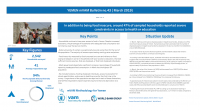Yemen mVAM Bulletin #43: March 2019 – In addition to being food insecure, around 47% of sampled households reported severe constraints in access to health or education
Key Points
- Households continue to have poor access to food in Yemen. Despite increased assistance, the percentage of households with adequate food consumption did not improve over the last six months.
- Dietary diversity of women is exceptionally low and worse than for the rest of the population. The majority of women report eating mainly grains and pulses.
- Food insecurity measured by food consumption score and reliance on food coping strategies is worse in households with poor access to education, that lack sufficient income sources, that are displaced, or that host displaced individuals.
- Marib governorate depicted a significant increase in percentage of households reporting inadequate food consumption. In Marib has the highest IDP population.
- We included violence, hosting displaced individuals, access to education for school-aged children, and access to health services for the first time in the survey. Large shares of the population are deprived in each of these dimensions, and half the respondents report experiencing more than one deprivation at a time.
Situation Update
- In March, fighting continues to displace people in Hajjah Governorate, already one of the most food insecure areas of Yemen. Humanitarian partners estimate that the number of displaced people in Hajjah Governorate has doubled in the last six months from 203,000 to around 420,000 people.
-In its latest Yemen Economic Monitoring Brief, the World Bank stated that Yemen’s economic and social fabric continues to disintegrate. - According to the World Bank report, available information and anecdotal evidences suggest that since 2014 Yemen’s GDP has contracted by 39 per cent and the poverty rate, defined using the World Bank’s International Poverty Line of a daily per capita consumption of $US1.90 PPP, is projected to have increased since 2014 by 33 percentage points, to approximately 52 percent of the population in 2019.
- In March, the value of the Yemen rial (YER) had decreased from YER575/US$ to about YER579/US$ over the previous month.
- According to WFP price monitoring, the price of petrol increased from YER293 to YER315 per litre and diesel from YER323 to YER358 per litre compared to February.
- Suspected cases of cholera have spiked in recent weeks. Data collected by the Ministry of Public Health and Population with the support of WHO indicates that 108,889 suspected cases and 190 associated deaths were recorded between 1 January and 17 March.
- Following the results of the latest IPC, WFP is scaling-up its assistance reaching in Febraury 9.3 beneficiaries with general food assistance, a 1.7 million increase compared to December 2018.


